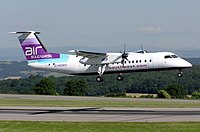Portal:Aviation/Selected Aircraft/15

The de Havilland Canada DHC-8, popularly the Dash 8, is a series of twin-turboprop airliners designed by de Havilland Canada in the early 1980s. They are now made by Bombardier Aerospace which purchased DHC from Boeing in 1992. Since 1996 the aircraft have been known as the Q Series, for "quiet", due to installation of the Active Noise and Vibration Suppression (ANVS) system designed to reduce cabin noise and vibration levels to near those of jet airliners.
Notable features of the Dash 8 design are the large T-tail intended to keep the tail free of propwash during takeoff, a very high aspect ratio wing, the elongated engine nacelles also holding the rearward-folding landing gear, and the pointed nose profile. First flight was in 1983, and the plane entered service in 1984 with NorOntair. Piedmont Airlines (formerly Henson Airlines) was the US launch customer for the Dash 8 in 1984.
The Dash 8 design had better cruise performance than the earlier Dash 7, was less expensive to operate, and more notably, much less expensive to maintain. The Dash 8 had the lowest costs per passenger mile of any feederliner of the era. The only disadvantage compared to the earlier Dash 7 was somewhat higher noise levels, but only in comparison as the Dash 7 was notable in the industry for extremely low noise due to its four very large and slow-turning propellers.
- Length: 107 ft 9 in (32.84 m)
- Wingspan: 93 ft 3 in (32.84 m)
- Height: 27 ft 5 in (8.34 m)
- Powerplant: 2× Pratt & Whitney Canada PW150A turboprops, 5,071 shp (3,781 kW) each
- Cruise speed: 360 knots (414 mph, 667 km/h)
- Maiden Flight: June 20, 1983
